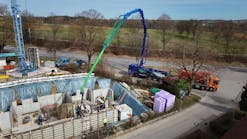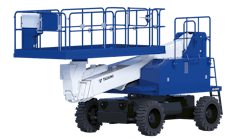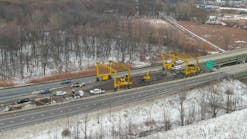Tips for Preventing Problems from Birds in a Construction Setting
Birds are all around us, at the park, at our work, at our schools and even our homes; they have grown accustomed to the "urban environment." And although they are an essential part to our eco-system, there is damage being done that we have overlooked.
According to the U.S. Public Health Service (USPHS) and the Infectious Diseases Society of America (IDSA), construction workers were listed as an occupation that has a high exposure risk to H. capsulatum spores. Dusts containing H. capsulatum spores can be aerolized during construction. The disease-causing fungus Histoplasma capsulatum can be breathed in causing illness to construction workers who are active in the removal of bat or bird feces from buildings.
People who become infected usually experience mild symptoms, therefore not seeking medical attention and go on not realizing that they are carrying the fungus. Histoplasmosis usually affects a person’s lungs. Flu-like symptoms such as fever, chest pain, cough, headache or losses of appetite are the noticeable side effects, but people tend to not link these symptoms to something like histoplamosis.
Advice for Construction Workers
Construction workers do have an option. There are skin tests available that informs about the susceptibility to H. capsulatum and experts suggest that water sprays and dust suppression techniques should be used to reduce the amount of dust aerolized during construction.
Construction equipment such as bulldozers, trucks and front-end loaders should have air filters available to protect the operators. Trucks carrying dirt or debris from a work site should be covered and washed before leaving the site. Although there are ways to prevent yourself from being infected and information available to recognize symptoms, avoiding the birds or bats altogether is what will really protect you.
Bird Droppings on the I-35W Bridge
On August 1, 2007, the I-35W Bridge in Minneapolis, MN collapsed into the Mississippi River. The collapse resulted in 13 deaths and over 100 wounded. The department of transportation workers found that pigeon droppings obscured their ability to inspect the bridge.
The Associated Press reported that experts believe that the droppings were a key factor in helping the bridge’s steel beam rust faster. In America alone it has been estimated that the damage from birds costs cities tens of millions of dollars per year. According to Town Lake Construction LLC, they have been using bird abatement products to avoid damage and disease. Bird netting is one of the many products that they have found effective.
The owner of general construction firm Tischler Brothers said, bird droppings affected multiple aspects of his business and tend to seriously degrade roofing materials.
Wood, metal and steel may erode faster due to the acidic properties of bird droppings left to fester over time. This can result in devaluation to property, construction sites, equipment and historic landmarks and can even be attributed to money loss and death.
Birds will nest just about anywhere that provides shelter and warmth including roofs, ceiling vents, wall vents, chimneys and soffits. Their nests can cause stains and structural damage. Bird feces corrode not only metal, but a number of building materials, including concrete, stone, tar shingles and brick.
On December 8, 2007, Patricia Nicola of Estero, FL, was visiting the Corkscrew Swamp Sanctuary in Naples when she suddenly stepped in bird feces sending her across the boardwalk fracturing her right shoulder. Nicola filed a lawsuit against the National Audubon Society, which own the sanctuary. Stating in her lawsuit that they had failed to keep the boardwalk clean or warn pedestrians of any hazardous areas. The lawsuit is currently pending; however the lawsuit seeks compensation for her injuries. An incident like Nicolas is unfortunate and may cost the sanctuary a big chunk of money.
Ways to protect your interests
A long-term effective solution for pest infestation is needed. There are products that are currently on the market that humanely deter and repel birds from infesting our property. Most turn to harmful methods to rid themselves of their pest problems, when, in fact, that just plain doesn’t work. Humane solutions that make an area inhospitable make pests like birds, bats, rodents, etc., leave for good. There are companies that specialize in safe, humane, non-toxic solutions that target a bird’s senses.
Taste aversions, which are applied to areas where birds feed is a popular tactic. The solution, which is not harmful to humans but is repulsive to the palate of birds, is mixed with water and is applied to grass, trees, crops and vegetation. Therefore the bird and/or pest are not harmed, but its taste buds are. Basically, when the food source goes, so will the pests. Be careful when deciding on a taste aversion solution. There are products available that have chemicals that can cause severe illness or death to the pests and even to humans who come in contact with it.
To avoid these risks, many property owners with more serious pest issues can try ultrasonic devices. An ultrasonic device uses sound waves that irritate birds, yet are silent to humans. They work well in semi-enclosed locations, like under a bridge, where the structure can reverberate and amplify the sound.
There are also sonic devices available as well that use real alarm sounds made by pest birds and predator sounds of their mortal enemies that scare the pests away. These devices work for larger areas and can carry up to six acres. Multiple sounds and programmable settings allow the user to vary the bird-scaring soundtrack for optimum impact. No matter how severe your pest infestation is, there is an assortment of products that can meet all levels of concern – both humanely and environmentally.
The key to success for all of them has been finding the right combination of non-lethal methods to convince birds to relocate. Killings birds will not solve the problem. As long as a location remains attractive to birds, others will move in after the initial group is eradicated. Successful deterrents convince invading birds that an area is no longer safe or desirable, or hinder their ability to comfortably roost in an area.
Taking simple preventative steps avoiding pest infestations and damage can help protect your business, workers and community from permanent bird cohabitation. Disease, destruction and debt are all consequences that can be avoided if the right actions are taken. Using products that target your specific needs will prevent and protect your work environment. Letting you and your workers concentrate on more important things like…new construction!
Kelly Crost is a media correspondent for Bird-X, Inc – specializing in "green" and humane bird deterrents and repellers for over 45 years. Bird-X, Inc. has worked with everyone from municipal buildings, construction companies, warehouses, departments of transportation, bus terminals and transit stations dealing with bird infestations. For more information, call 800-662-5021 or visit the website: www.bird-x.com



